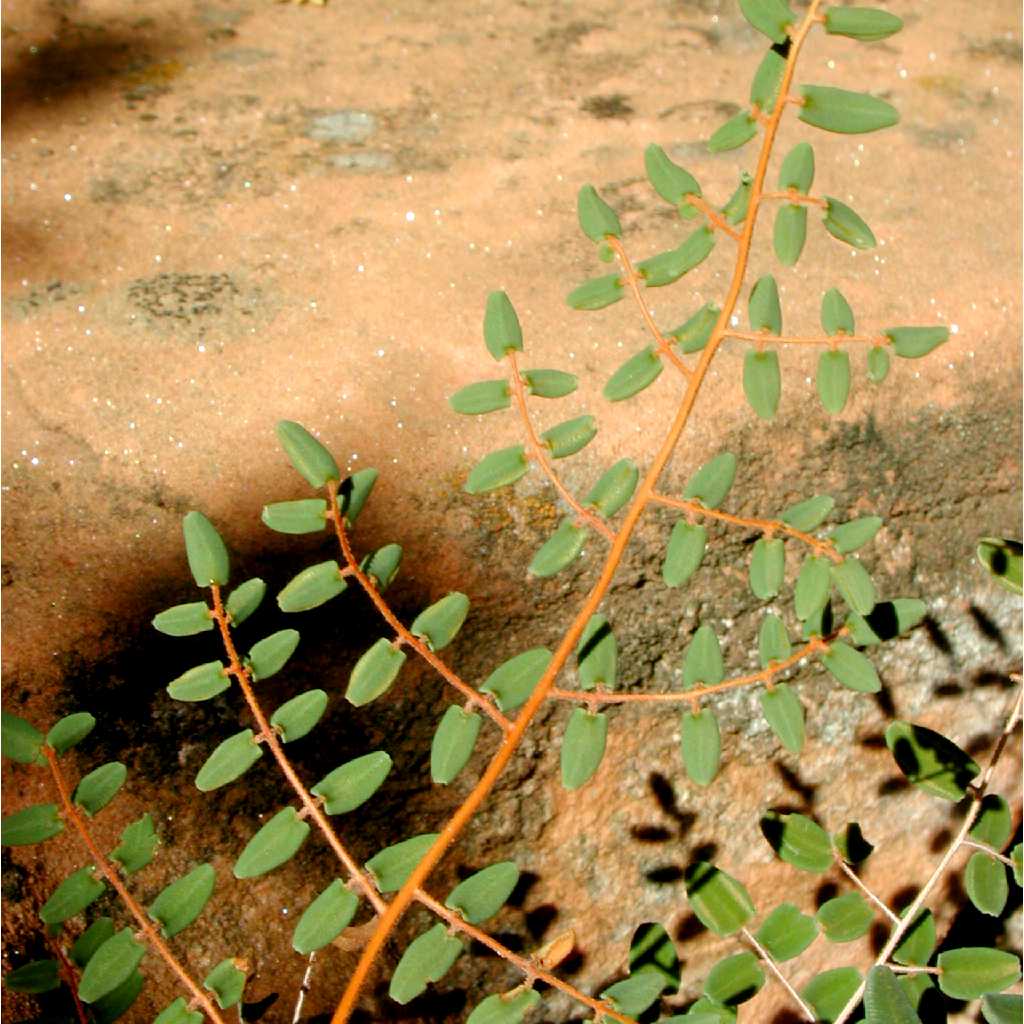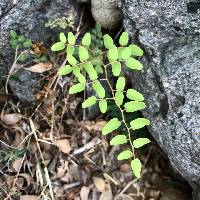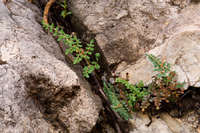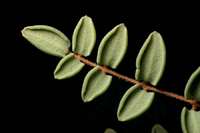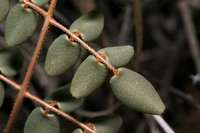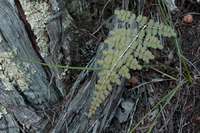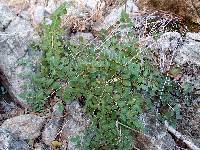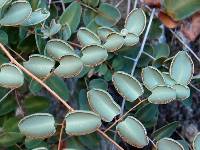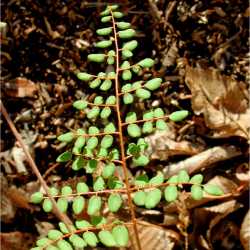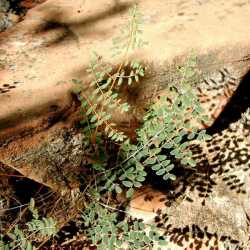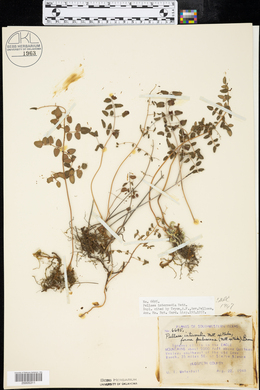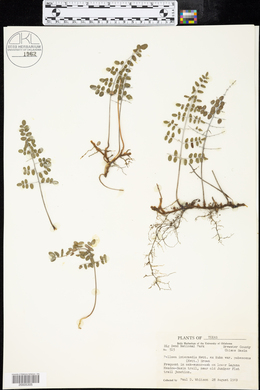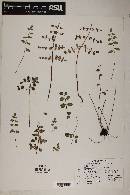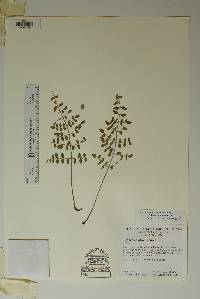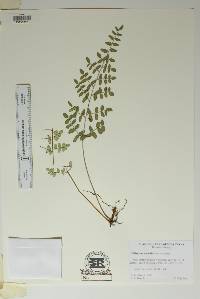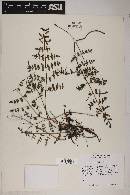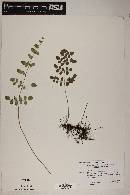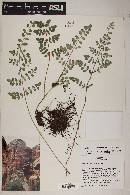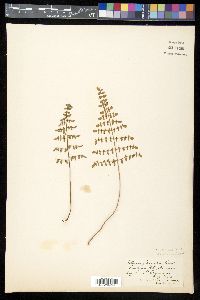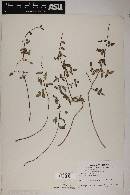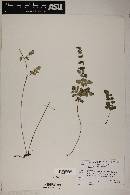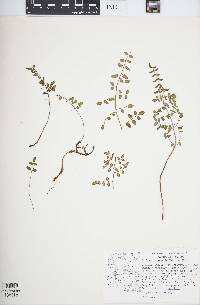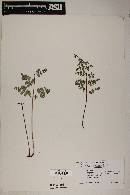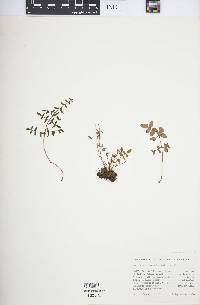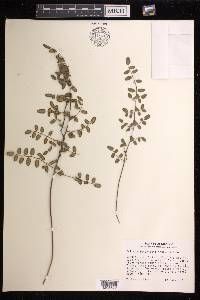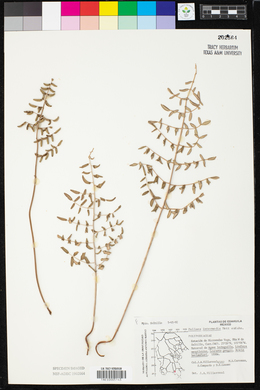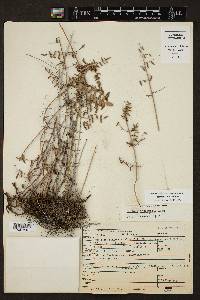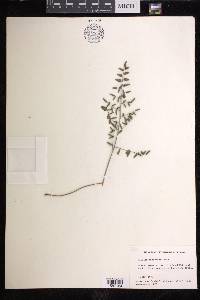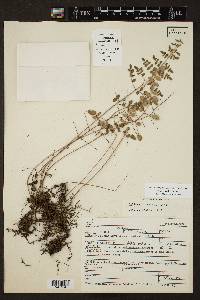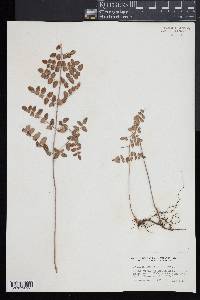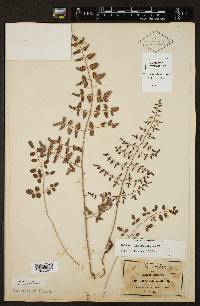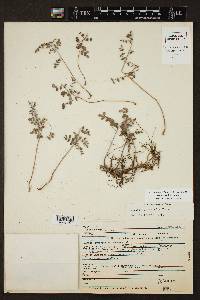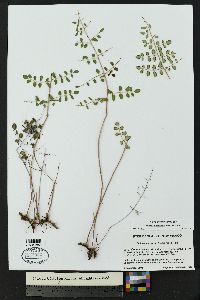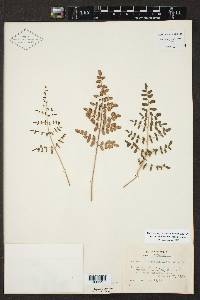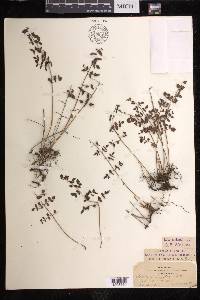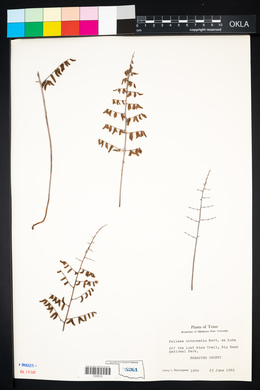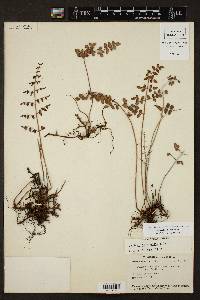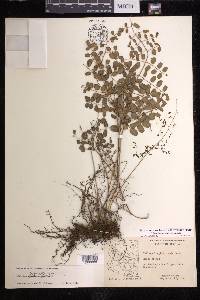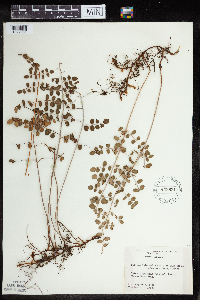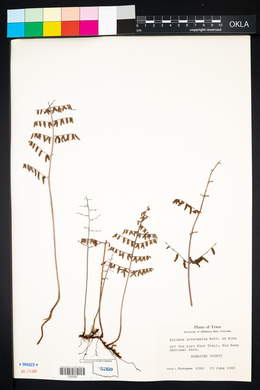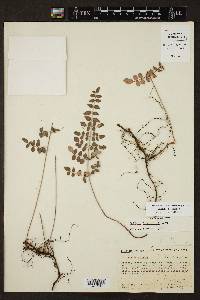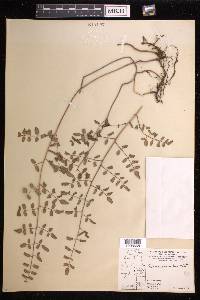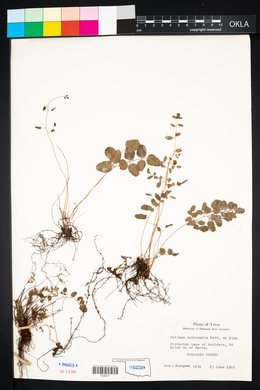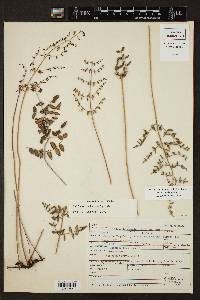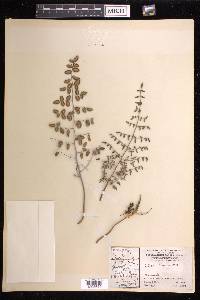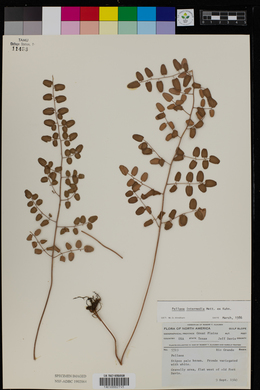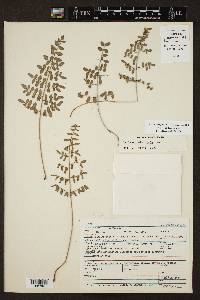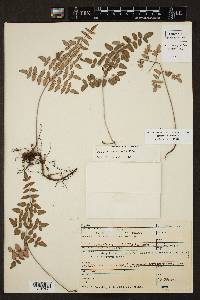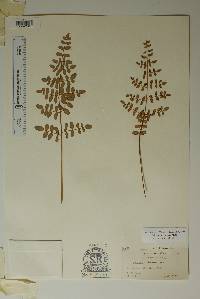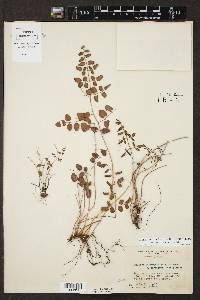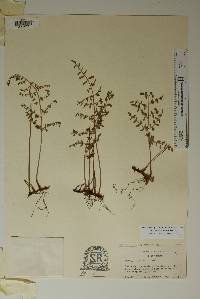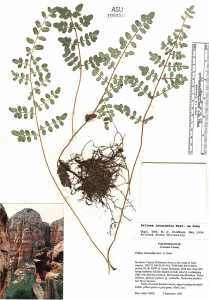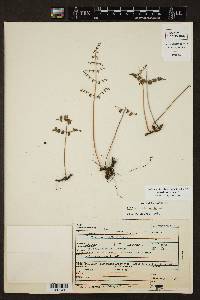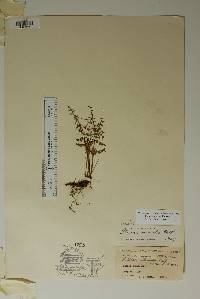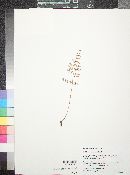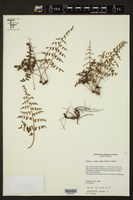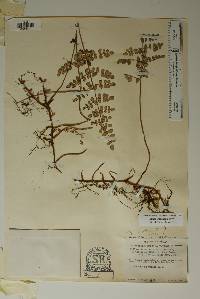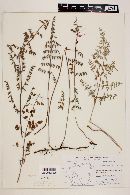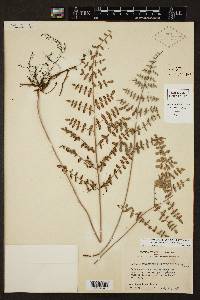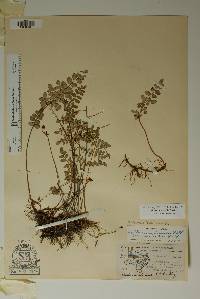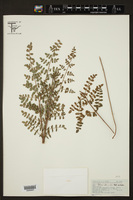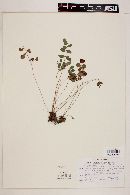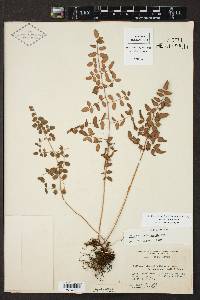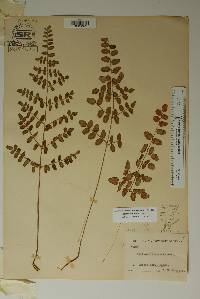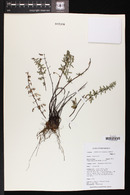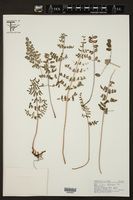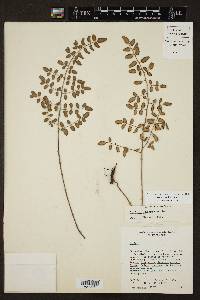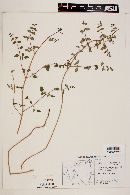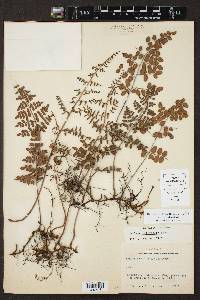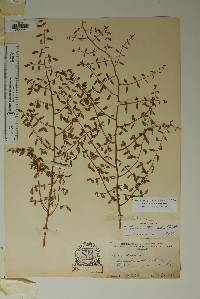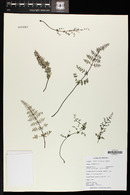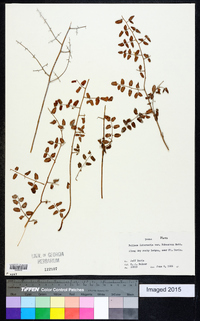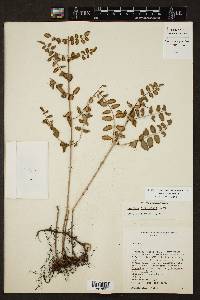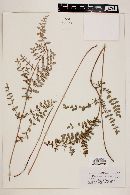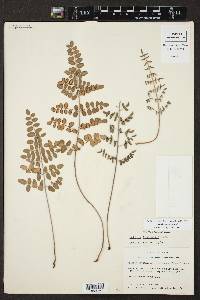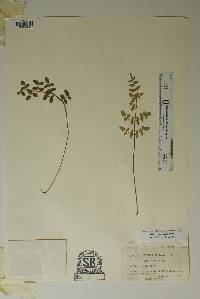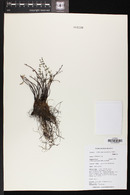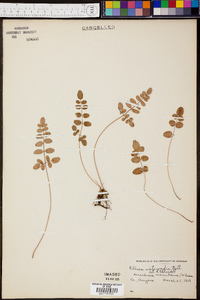Pellaea intermedia
|
|
|
|
Family: Pteridaceae
Intermediate Cliffbrake
[Pellaea intermedia f. pubescens (Mett.) M. Broun, morePellaea intermedia var. pubescens Mett. ex Kuhn] |
Stems creeping, horizontal, slender, 2--4 mm diam.; scales mostly bicolored, narrowly lanceolate, largest scales 0.3--0.8 mm wide, centers black, thick, margins brown, thin, irregularly dentate. Leaves monomorphic, widely scattered along stem, 12--50 cm; croziers pubescent and bearing a few scales. Petiole straw-colored, tan, or gray, not lustrous, rounded or slightly flattened adaxially, without prominent articulation lines. Blade ovate to elongate-deltate, usually 2-pinnate proximally, 4--20 cm wide; rachis tan throughout, straight to slightly flexuous, rounded or flattened adaxially, ± pubescent. Pinnae perpendicular to rachis or slightly ascending, not decurrent on rachis, usually with 7--21 ultimate segments; costae straight to slightly flexuous, 20--100 mm, longer than ultimate segments. Ultimate segments ovate to elliptic, 5--15 mm, leathery, glabrous or usually puberulent abaxially; margins recurved on fertile segments, usually covering less than 1/2 abaxial surface, borders whitish, nearly entire; apex obtuse to slightly mucronate. Veins of ultimate segments obscure. Sporangia short-stalked, containing 32 spores, not intermixed with farina-producing glands. n = 2 n = 87, 116, apogamous. Sporulating summer--fall. Rocky slopes and ledges, on a variety of substrates, including limestone and granite; 300--2400 m; Ariz., N.Mex., Tex.; n Mexico. Plants of Pellaea intermedia in the flora are apogamous triploids and tetraploids; a sexual diploid cytotype has been found near Saltillo, Mexico (A. F. Tryon 1968). Given the high degree of morphologic similarity among the three cytotypes, the North American polyploids probably were derived from the Mexican diploid through autopolyploidy.
General: Stems creeping, horizontal, slender with widely scattered leaves 12-50 cm, stem 2-4 mm in diameter, with bicolored scales, narrowly lanceolate, largest 0.3-0.8 mm wide, centers black, thin, margins brown, thin, irregularly dentate. Leaves: On straw-colored petiole, tan, not lustrous, rounded or slightly flattened above; blade ovate to elongate-deltate, usually 2-pinnate below, 4-20 cm wide, rachis tan throughout, straight to slightly flexuous, rounded or flattened above, pubescent; pinnae perpendicular to rachis or slightly ascending, not decurrent on rachis, usually with 7-21 ultimate segments; costae straight to slightly flexuous, 20-100 mm, longer than ultimate segments; ultimate segments ovate to elliptic, 5-15 mm, leathery, glabrous or usually puberulent below; margins recurved on fertile segments, usually less than half the lower surface, borders whitish, entire, apex obtuse to slightly mucronate. Sporangia: Short-stalked, with 32 spores, partially covered by the false indusium of the recurved margin. Ecology: Found on rocky slopes and ledges, on a variety of substrates from 1,000-8,000 ft (305-2438 m); sporulates summer-fall. Notes: Distinguished by the cordlike creeping rhizomes, its larger leaves for the Pellaea complex, and whitish upper surface of the central rachis. Etymology: Pellaea is from the Greek pellaios, dark, alluding to the stalk, while intermedia means in between. Sources: FNA 1993, Dittmer et al. 1954 FNA 1993, Dittmer et al. 1954 Common Name: intermediate cliffbrake General: Stems creeping, horizontal, slender with widely scattered leaves 12-50 cm, stem 2-4 mm in diameter, with bicolored scales, narrowly lanceolate, largest 0.3-0.8 mm wide, centers black, thin, margins brown, thin, irregularly dentate. Leaves: On straw-colored petiole, tan, not lustrous, rounded or slightly flattened above; blade ovate to elongate-deltate, usually 2-pinnate below, 4-20 cm wide, rachis tan throughout, straight to slightly flexuous, rounded or flattened above, pubescent; pinnae perpendicular to rachis or slightly ascending, not decurrent on rachis, usually with 7-21 ultimate segments; costae straight to slightly flexuous, 20-100 mm, longer than ultimate segments; ultimate segments ovate to elliptic, 5-15 mm, leathery, glabrous or usually puberulent below; margins recurved on fertile segments, usually less than half the lower surface, borders whitish, entire, apex obtuse to slightly mucronate. Sporangia: Short-stalked, with 32 spores, partially covered by the false indusium of the recurved margin. Ecology: Found on rocky slopes and ledges, on a variety of substrates from 1,000-8,000 ft (305-2438 m); sporulates summer-fall. Notes: Distinguished by the cordlike creeping rhizomes, its larger leaves for the Pellaea complex, and whitish upper surface of the central rachis. Ethnobotany: Unknown Etymology: Pellaea is from the Greek pellaios, dark, alluding to the stalk, while intermedia means in between. Synonyms: None Editor: SBuckley, 2010 |
|
|
|

